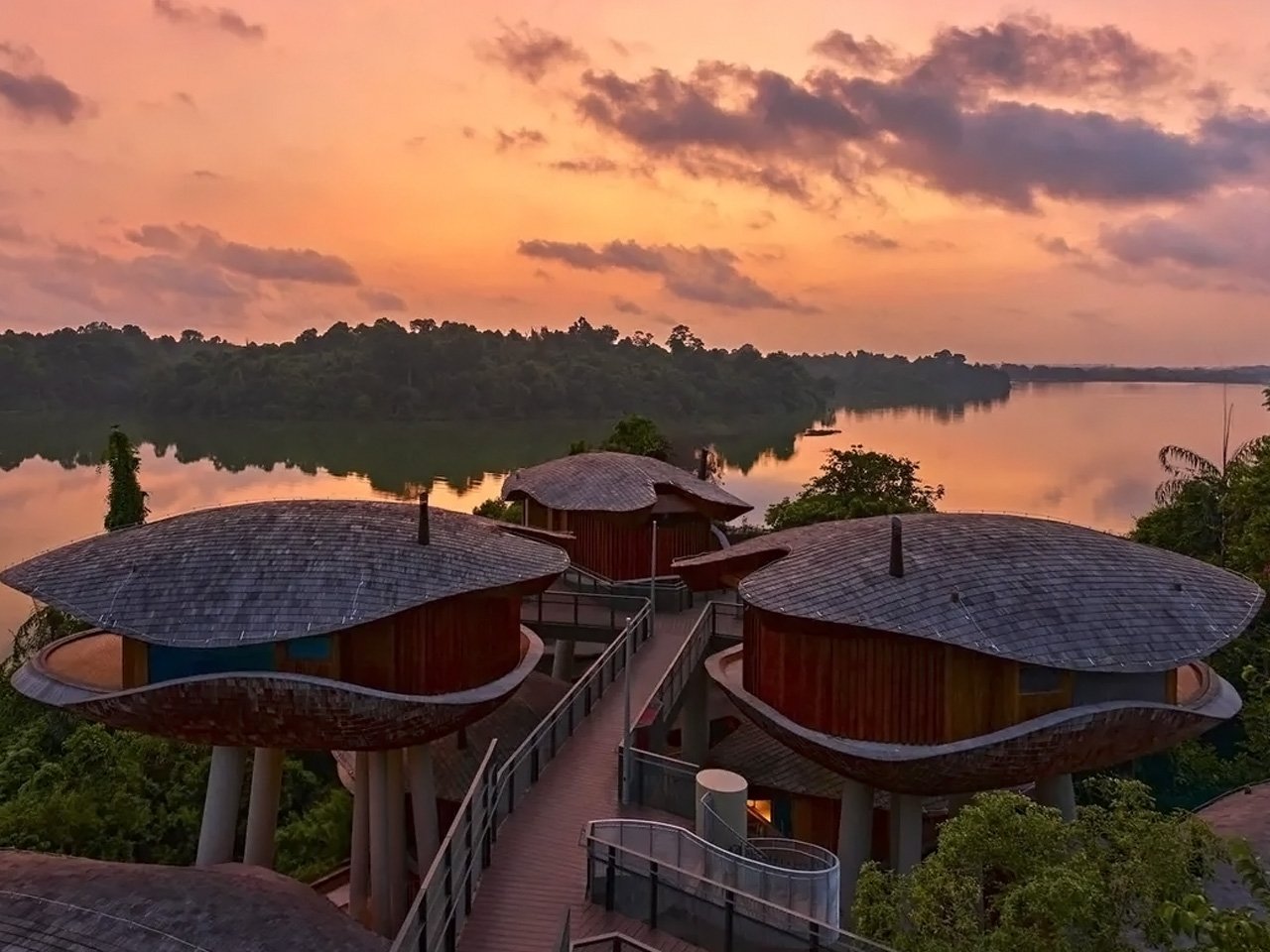WOW Architects has delivered Singapore’s most ambitious biophilic resort with the opening of Mandai Rainforest Resort by Banyan Tree. The 11-acre property is the nation’s first to achieve Super Low Energy certification, while also creating an immersive forest experience. Co-founder Chiu Man Wong and his team won the competitive tender by proposing a regenerative approach that gives back more than it takes from the site. The resort’s stunning seed-pod-shaped treehouses emerge from the canopy like natural formations, establishing a new vocabulary for eco-luxury hospitality.
The architectural strategy centers on seamless integration with the existing forest ecosystem. WOW Architects carefully positioned the resort within the footprint of former back-of-house facilities, minimizing disturbance to surrounding vegetation while maximizing the site’s natural assets. Trees of conservation value were retained while introducing native species to enrich the biodiversity. Rooftop forests and living facades expand the green surface area beyond the original site conditions. The open-air lobby allows tropical breezes to flow through the space while reducing mechanical cooling loads.
Designer: WOW Architects
What Is Regenerative Hospitality
Regenerative hospitality transforms how resorts and hotels interact with their natural environment. Unlike traditional eco-friendly practices that focus on reducing harm, regenerative hospitality actively restores and enhances the destinations where hotels and resorts operate. This emerging paradigm seeks to leave communities, ecosystems, and cultural landscapes better than they were found.
Properties built on regenerative principles become living ecosystems that nurture biodiversity and empower the local people without disrupting their lives. These thoughtfully designed spaces function as engines of positive change, encouraging both environmental healing and community growth.
The seed pod treehouses are the project’s most alluring architectural achievement. These organically shaped structures float within the forest canopy, their curved forms seamlessly aligning with the natural geometry of branches and leaves. The organic forms proudly showcase biomorphic design without sacrificing comfort or functionality. The structure’s elevated position provides natural cooling through cross-ventilation while offering immersive canopy views that change throughout the day.
The Super Low Energy certification requires 40% less energy consumption than comparable properties, achieved through passive design strategies and renewable energy systems. Mixed-mode air conditioning allows natural ventilation when conditions permit, while solar panels contribute to the resort’s energy independence. Natural materials and locally-sourced elements reduce embodied energy while creating authentic connections to Singapore’s tropical context.
The resort’s spa and wellness facilities extend the biophilic design philosophy into intimate therapeutic spaces. The 345-square-meter spa features three spa pavilions and three wellness pods nestled within a forest setting, where the sounds of wildlife replace traditional ambient music. Wellness programming takes advantage of the natural environment, with forest bathing sessions and outdoor yoga platforms that blur the boundaries between built and natural spaces.
Mandai Rainforest Resort sets a new and impressive benchmark for regenerative hospitality design in Southeast Asia. WOW Architects has created more than a luxury resort; they have crafted a living ecosystem that displays architecture’s potential to heal rather than harm.
FAQs
1. What is biophilic design in hospitality?
Biophilic design in hospitality is an architectural and interior strategy that intentionally connects guests to nature within built environments. It uses natural materials, abundant daylight, organic forms, and views of greenery or water to create spaces that support well-being and comfort. In resorts like Mandai Rainforest Resort, biophilic design is evident in the seamless integration of guest spaces with the surrounding rainforest, allowing visitors to experience the healing and calming effects of nature throughout their stay.
2. What are the principles of biophilic resort design?
The principles of biophilic resort design are rooted in fostering a strong connection between people and the natural world. The key principles include:
Nature in the Space: Direct presence of natural elements such as plants, water features, and daylight.
Nature of the Space: Spatial configurations that evoke feelings of prospect, refuge, and mystery, often through open views, cozy nooks, and organic circulation.
Natural Analogues: Use of materials, colors, and patterns that mimic natural forms and processes.
At Mandai Rainforest Resort, these principles are realized through treehouse accommodations that float within the forest canopy, open-air lobbies, and the use of locally sourced, natural materials.
3. How does regenerative hospitality differ from sustainable hospitality?
While sustainable hospitality focuses on minimizing negative impacts on the environment and local communities, regenerative hospitality goes a step further by actively restoring and improving them. Regenerative hospitality aims to leave a destination better than it was found, enhancing biodiversity, supporting local economies, and fostering deeper community connections. Mandai Rainforest Resort does this by reducing its environmental footprint and also enriching the local ecosystem and community through thoughtful design and operations.
The post How Singapore’s First ‘Regenerative’ Resort Is Transforming Eco-Luxury Hospitality first appeared on Yanko Design.

